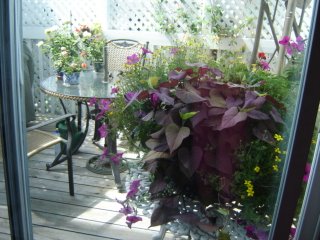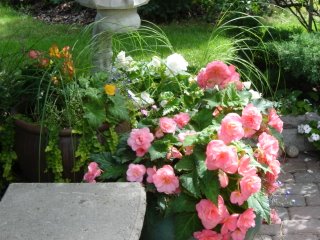Containers - Gardening in Miniature





Haven't got room for a garden? Haven't time to grow and nurture a garden? You'd like to enjoy some seasonal colour, to be able to place some colourful growing things within easy view, plants that won't demand much time and attention? Do some miniature gardening, in a container.
Their availability is wide; garden containers are popular and sold almost everywhere one can think of: hardware stores, general-purpose emporiums, and garden centres. You can buy wood, resin, plastic, unglazed or glazed clay, (terra cotta), stone, cement, iron (urns); anything your heart desires. These can range in price from a few dollars to a whole lot more.
The resin and plastic types are light in weight, easily stored, not quite as susceptible to breakage as the terra cotta. They should be more reasonable in price but aren't always. Terra cotta pots should be emptied of their summer contents, cleansed and stored in a place where they will be protected from winter weather. Stone or cement urns should be covered to ensure no moisture, snow or ice enters their cavities to freeze, thaw, then undergo the same cycle, as they can develop cracks. Iron can be indestructible, but of course it can rust.
Regardless of the container, whether it's of simple, plain design, a "box", a square, oblong, or a design resembling the rococco of 18th century French copies, or more restrained classical urns, these are meant for practical gardening use, to highlight the flowers and plants you plan to install in them. Having done so, you can be assured of wonderful viewing pleasure throughout the summer months.
Planters need to be watered regularly; more often than plants and flowers installed directly into flower beds. Watering requirements are more frequent in the first month of planting and growing; when the plants have matured sufficiently to cover the open surface of their container, less water is lost (water is lost more readily from terra cotta than from resin containers) and watering may sometimes be reduced to two to three times a week, depending upon the size and location of your container.
Containers in direct sun will need watering more often than containers in semi-shaded positions. Plants confined to such a relatively small area will also require the addition of fertilizer to replenish the nutrients taken from their limited soil options; three to four times throughout the summer may work nicely if an all-purpose flower fertilizer is used. At the time of original planting, the soil should be amended with peat moss and sprinkled liberally with bonemeal - this should be supplemented with fertilizer throughout the growing season for best results in floral displays.
As for planting, you are only limited by your imagination, by your creative impulses. Small trees can be planted in over-sized containers which won't freeze completely through over the winter months. Perennials like hostas do very nicely after the summer, cut down to soil level, then left in their pots, given a modicum of protection, then brought out again in the spring, to flourish once again. Same for some perennial herbs.
A standard for a well-thought-out planter is something tall in the centre (grasses work nicely, dracaenia, canna lily, even a tall-growing flower like fuschia or marigolds); surrounded by lower-growing-habit flowers the very most successful of which can be New Guineau impatiens, or tuberous begonias, but there are a plethora of others. Between those spreading plants with continuous flowering habits like million bells, nemisia, mimulus, bacopa, and many others give texture and bright colour. Last, trailing plants like ivy, potato vine, lobelia and others; options are endless.
It's worth the effort.

<< Home